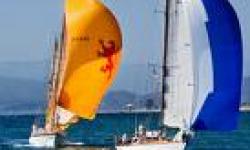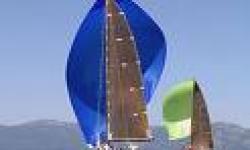IRC Rating Secret Formula
Is it a random number generator?
With the above formula having been around and well tested prior to Y2K as the CHS rating formula, and evolved into the IRC formula rating, where is it going?
With yacht?s built before 2000, and with the core racing fleet at this time being moderate displacement cruiser/racers between 30 to 40 ft, the IRC model gives very consistent results with similar boats (size and SA/D , DLR) and works really well. There are some anomalies such as smaller day boats, in 25 to 28 ft range, such as Lavranos L-26, J-Boat?s J-27, Laser 28 designs in the main being rated several % below comparative IRC# of a comparable larger C/R rating #, and being a larger boat against which they would normally compete with on a PHRF basis. The only measure on these boats which stand out from normal C/R would be a fairly low hounds height with P measure much greater than L measure, and with a LL/P fraction at about 0.9 would give about 3% better rating compared to other fractional (LL/P = 1.0) rigged boat of current generation.
Some mid size C/R?s of this era in 34-35 ft range with similar profile also had the very nice LL/P factor around 0.9, so should shine under IRC Rating, but do not as with their spinnaker size being very moderate in area, and often only twice size of mainsail, become very expensive under spinnaker % in total rating model.
Current optimized C/R?s have spinnaker?s about 2.5 times mainsail area to rate well. Also some of these pre-2000 yacht(s) with fractional rigs have expensive P/E ratios (see below), and which would have clawed back some of LL/P advantage?.
If run the data for the P/E measure?s, the model would seem to be expensive for high P/E #?s, on the solid basis that a high aspect ratio performs much better to weather?just a like a high aspect non-overlapping jib, and that the best way to reduce this cost is by pushing the boom ?E? as far back as possible to get maximum benefit from the secret formula.
Now if take the normal form of regression rating model (IRC uses such (?) as calls its IRC model an ?IRC Rating formula?). Said model would be a line of mix and match measures and factors, and which when even out the over?s and under?s from a large sampling population, will provide a best guess rating #.....but does not give boat speed at all!
This regression formula would be on line of immersed waterline x combined sail area pro-rated over estimated course (being main at 100% plus foresail at 60% and spinnaker at 40%) x DLR to factor mass into model with perhaps X SA/D, and then a few fine-tune adjustment for LL/P, P/E, propellers type, keel type, mast and rigging items etc.
With sample population at this (y2k) era, the only boats which stuck out were the abovementioned day boat styles which had a below parity LL/P (< 1.0) fractional rig?s and much faster downwind vs. upwind speeds in range 1.20 to 1.40:1, when the average C/R was about 1.12:1, an ?on the water? IRC Rating advantage of about 2.5 to 3.0%. One could only assume that it?s a combination of LL/P combined with good P/E measure?s or mixed with an average of combined sail area vs. individually calculated up and downwind areas, that the average combined sail areas did not reflect in model the huge variances to each side of rating in actual speeds.
Post 2000, and as designer?s looked for a sweet spot in IRC Rating #, the foresail was dropped to an non-overlapping jib and bigger spinnaker to get more performance for same number. In simple numbers of a sample yacht with main 30m2, genoa at 30m2 and spinnaker at 60m2, this historic calculation would have been Mainsail (*100%) + foresail (*60%) and spinnaker (*40%), a total area of 30+18+24=72m2
Now with non-overlap, can drop the foresail by about 20% and up the spinnaker by 20%, and turn the boat into a relative bandit with data now at:
30(100%) +24(60%) +72(*40%) and end up with a total area of 30+14.4+28.8 = 73.2
So effective rating goes up by 1.6%, but by remodeling jib and mast with higher mast hounds to grow LL measure, can get the same upwind power with smaller and taller high aspect jib, but generate a huge increase in downwind sail area by 12.0m2 (from 90m2 to 102m2), an increase of 13.3% in area.
Now compare actual combined area of overlapping sail at 120M and rating 72m2, vs. non overlapping sail areas of 126m2 and rated area of 73.8.
i.a.w. 6 m2 of extra sail area brought a rating penalty only 1.8m2. No surprise the change in trends post 2000 for this sail configuration advantage under said ?secret formula?.
But speed is a factor of immersed waterline x power factor. Power factor, ignoring constants, would be an approximation of cube root of (S/A)/ quad root of (D), with D in this case being a constant as is comparative of sail configuration on same hull.
The net performance advantage # here would be about 2.36% downwind, and if factor into downwind distance at 40%, we have a net rating advantage of about 0.95%. Does not sound like much, but with top 3 boats corrected time often within 1% and seconds between boats, said advantage is about 34 seconds a hour ( IRC ?TOT? talk ) or just under 6 seconds/mile (USA talk) advantage.
Some post 2000 designs, such as fractionally rigged Performance Cruisers, don?t rate at all well under IRC. They have same LL/P measure as a masthead rig in many cases, but have very moderate area overlapping genoa?s (as are a fast cruiser with no pretentions of being a racer), but are seen by the LL/P measure as having huge genoa area in region of 50% bigger than mainsail area, when have genoa area?s usually equal to or very close to mainsail area. A complete disaster for boats such as these in rating model, and a flaw in said IRC Rating Secret Formula model.
With pattern of IRC Rating?s providing closest racing in and around the 12 to 14kts wind speed range for a lot of the fleet, and with data close to ORCi and LYS in light wind (5-6 m/s) regions, those racing in windier areas can profile their boat for downwind performance as is very cheap on spinnaker rating and can get a lot more downwind speed for little rating cost.



IRC Rating Secret Formula reviews
Login to comment